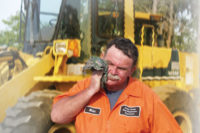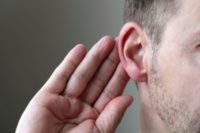Every year, about 30 million people in the U.S. are occupationally exposed to hazardous noise that can lead to noise-induced hearing loss. Exposure to these sounds on the job can cause permanent hearing damage, which cannot be corrected by surgery or a hearing aid. According to the Bureau of Labor Statistics, more than 125,000 workers have suffered significant permanent hearing loss since 2004, with additional reports in 2009 alone of more than 21,000 hearing loss cases.
At a typical construction site, workers are exposed to many types of noisy operations. Hearing loss from loud noise limits your ability to hear high frequencies, understand speech, and reduces your ability to communicate, which can lead to social isolation. At a construction site, loud noise can also reduce work productivity and contribute to workplace accidents by making it difficult to hear warning signals.
Dangerous decibels
Sound is measured on the decibel scale, and an increase of 10 means that a sound is 10 times more intense; to your ears, it sounds twice as loud. To put hazardous noises in perspective, here is a list of common sources of noise and the OSHA level for a hearing conservation program.
Safe and sound prevention methods
Since there is no cure for permanent hearing loss, it is critical in a construction zone to prevent exposure to excessive noise as much as possible. There are ways to reduce your exposure when jobs produce high noise levels, and reduction of even a few decibels greatly lowers the hazard to hearing and noise-related annoyance.
OSHA currently allows employers to rely on any combination of (1) hearing protective devices with a hearing conservation program, (2) engineering controls, and (3) administrative controls to effectively reduce worker exposures below 90 dBA. OSHA also recommends that employers provide and workers use hearing protective devices any time site exposures meet or exceed 85 dBA. Additionally, federal and state laws set legal limits on companies whose workers are exposed to high noise levels in the workplace, permitting shorter durations of exposure as the hazardous noise level rises.
Hearing conservation programs should contain provisions for identifying and evaluating high noise exposures, controlling and reducing noises in the workplace, and ways to monitor workers’ hearing. The key elements of a Hearing Loss Prevention program are:
• Monitoring – Noise exposure levels must be measured wherever they may reasonably be expected to be above an eight hour time weighted average of 85 dBA.
• Noise Controls – Must be evaluated and implemented wherever employee exposures are at or above an eight hour time weighted average of 90 dBA.
• Audiometric Testing Program – All employees with an eight hour time-weighted exposure of 85 dBA or above must be included in an audiometric testing program. A baseline audiogram must be established within the first six months of exposure and annual testing and evaluation must be done.
• Hearing Protection – Employers must provide hearing protection for all employees who have an eight hour time weighted exposure of 85 dBA or above, who have any continuous exposure at or above 115 dBA, or who have an exposure to any impulse noise levels above 140 dB.
• Training – Employers must provide training to all employees exposed to noise at or above an eight hour time weighted average of 85 dBA. Training must include the following items: the effects of noise on hearing, information on hearing protectors and their use, information on audiometric testing and its purpose, and the employees’ right to access to records. The employer must maintain a written description of the training program.
Engineering controls involve making physical changes at the noise source, such as modifying or replacing equipment, or along the transmission path to ensure the worker is not overexposed. OSHA examples of inexpensive, effective engineering controls include:
• Choose low-noise tools and machinery
• Maintain and lubricate machinery and equipment
• Place a barrier between the noise source and employee
• Enclose or isolate the noise source
Administrative controls create changes in the workplace through distance and separation from the noise source with the goal of reducing or eliminating the worker’s exposure, which can be a challenge when working on a construction site. In open space, noise is decreased by 6 dBA for every doubling of the distance between the source of noise and the worker. Examples include:
• Operating noisy machines during shifts when fewer people are exposed
• Limiting the amount of time a person spends at a noise source
• Providing quiet areas where workers can gain relief from hazardous noise sources, such as a soundproof room
• Restricting worker presence to a suitable distance away from noisy equipment
When engineering or administrative controls are not feasible, hearing protection devices, such as earmuffs and plugs, are considered an acceptable but less desirable option to control exposures to noise. They should also be used when a worker’s hearing tests indicate significant hearing damage.
Know your noise exposure
Despite these efforts, an estimated 15 percent of workers will develop hearing loss this year from exposure to noise levels of 85 dBA or higher, according to the National Institute for Occupational Safety and Health (NIOSH). Don’t become a part of this statistic; find out for yourself if you are at risk for hearing loss at your job. As a good rule of thumb, if you have to shout to be heard by a co-worker who is arm’s length away or hear ringing or humming in your ears when you leave work, these are warning signs of a workplace with excessive noise levels.
References
"Noise Exposure - Hearing Loss." Health and Safety Topics. Washington State Department of Labor & Industries, n.d. Web. 3 July 2014. <http://www.lni.wa.gov/Safety/Topics/AtoZ/NoiseHearing/default.asp>.
"Noise-Induced Hearing Loss." National Institute on Deafness and Other Communication Disorders. National Institutes of Health, Oct. 2008. Web.2 July 2014. <http://www.nidcd.nih.gov/health/hearing/pages/noise.aspx>.
"Occupational Noise Exposure." Safety and Health Topics. United States Department of Labor, n.d. Web.3 July 2014. <http://www.osha.gov/SLTC/noisehearingconservation/>.



